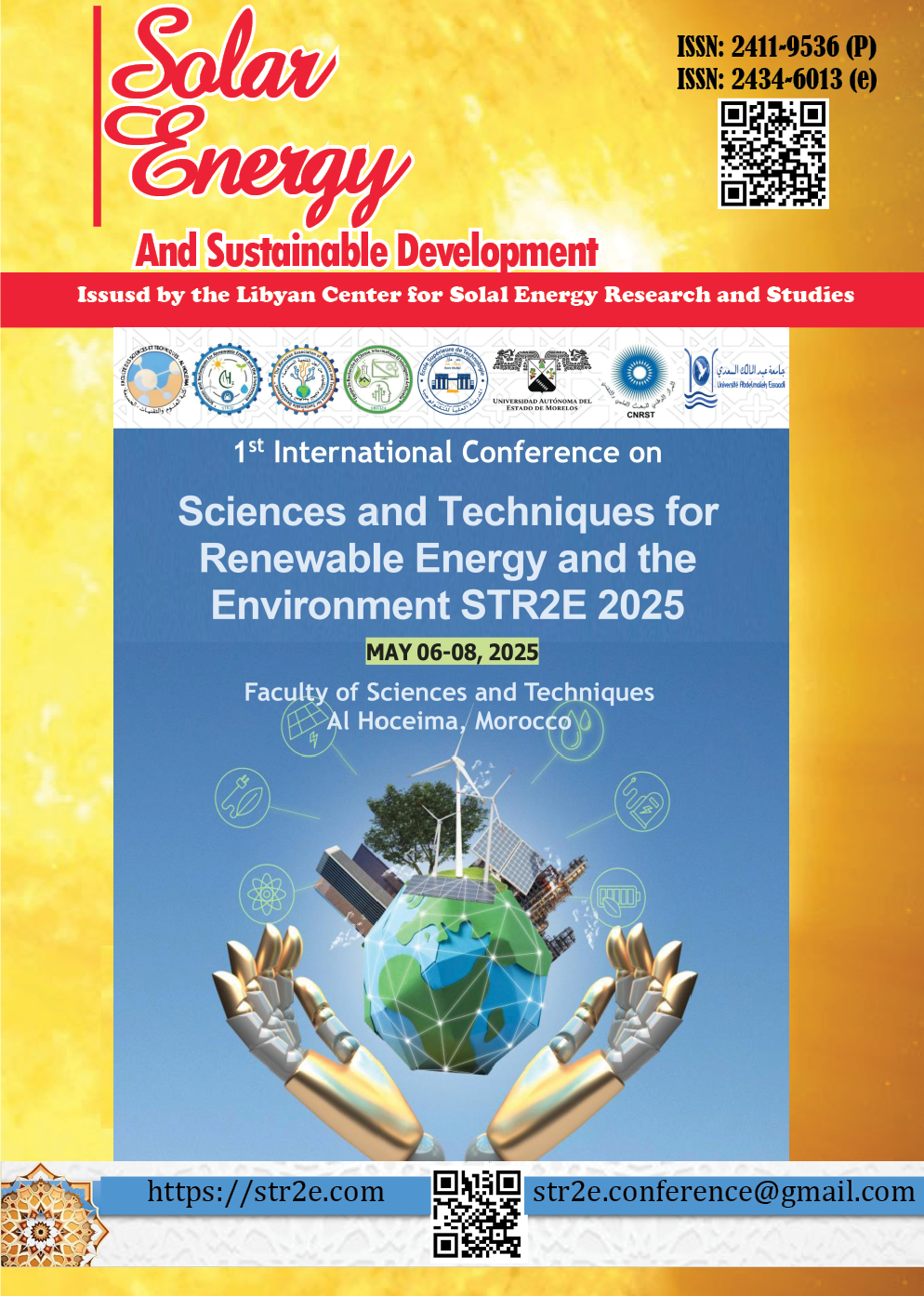Optimization of Adobe and Sawdust-Based Bricks for Improved Energy Efficiency in Construction
DOI:
https://doi.org/10.51646/jsesd.v14iSTR2E.983الكلمات المفتاحية:
Adobe bricks، Sawdust، Thermal performance، Energy efficiency، Sustainable construction.الملخص
The exploration of bio-based materials for sustainable construction practices, particularly through the use of locally sourced resources like sawdust, is the focus of this study, which evaluates the thermal performance of adobe bricks reinforced with 2% sawdust in small, medium, and large sizes, ranging from 0.3 to 2 cm. The bricks were manufactured using local materials, and the physicochemical properties of the clay were initially analyzed and characterized. The laboratory examined the bricks' thermophysical characteristics, such as their density, thermal conductivity, and heat capacity. The TRNSYS program was used to conduct annual thermal simulations based on representative meteorological data for a typical building in the semi-arid Moroccan city of Beni Mellal. The results indicate that the energy savings achieved in terms of both heating and cooling were comparable across all configurations of sawdust-reinforced adobe bricks. When compared to a reference concrete building, the heating energy demand was reduced by 59.14% for clay without sawdust, 72.61% for clay with small sawdust, 71.25% for clay with medium sawdust, and 69.88% for clay with large sawdust. Similarly, the cooling energy demand reductions were 45.71%, 58.82%, 57.68%, and 56.62%, respectively, for clay without sawdust, and with small, medium, and large sawdust. These findings suggest that the incorporation of sawdust, regardless of particle size, leads to similar energy savings, offering flexibility in utilizing locally available sawdust from Beni Mellal to optimize energy performance. This research highlights the importance of local clay-based materials and the use of sawdust as a natural reinforcement, to optimize the energy efficiency of buildings. It also offers new perspectives for their integration into sustainable construction practices, contributing to global sustainable development goals.
التنزيلات
المقاييس
المراجع
I. Bouchefra, F. Z. EL Bichri, H. Chehouani, and B. Benhamou, “Mechanical and thermophysical properties of compressed earth brick rienforced by raw and treated doum fibers,” Constr Build Mater, vol. 318, p. 126031, Feb. 2022, doi: 10.1016/J.CONBUILDMAT.2021.126031.
M. Benfars, A. Alioui, Y. Azalam, M. Kaddiri, and M. Mabrouki, “Impact of Ecological Thermal Roof Insulation on the Energy Efficiency of Conventional Buildings in a Semi-Arid Climate,” Solar Energy and Sustainable Development Journal, pp. 78–88, Dec. 2024, doi: 10.51646/jsesd.v14iSI_MSMS2E.401. DOI: https://doi.org/10.51646/jsesd.v14iSI_MSMS2E.401
Y. Chihab, N. Laaroussi, and M. Garoum, “Thermal performance and energy efficiency of the composite clay and hemp fibers,” Journal of Building Engineering, vol. 73, Aug. 2023, doi: 10.1016/j.jobe.2023.106810. DOI: https://doi.org/10.1016/j.jobe.2023.106810
S. Raefat, M. Garoum, N. Laaroussi, and Y. Chihab, “A simple laboratory flash apparatus for thermal diffusivity measurement: Modeling and application for composite material based on clay and straw,” Case Studies in Construction Materials, vol. 15, Dec. 2021, doi: 10.1016/j.cscm.2021.e00657. DOI: https://doi.org/10.1016/j.cscm.2021.e00657
F. Z. El Wardi, S. Ladouy, A. Atbir, and A. Khabbazi, “Study of the thermal and mechanical properties of local clay materials activated with quicklime, Sefrou (Morocco),” Mater Today Proc, vol. 58, pp. 1423–1430, Jan. 2022, doi: 10.1016/j.matpr.2022.02.348. DOI: https://doi.org/10.1016/j.matpr.2022.02.348
P. Melià, G. Ruggieri, S. Sabbadini, and G. Dotelli, “Environmental impacts of natural and conventional building materials: A case study on earth plasters,” J Clean Prod, vol. 80, pp. 179–186, Oct. 2014, doi: 10.1016/j.jclepro.2014.05.073. DOI: https://doi.org/10.1016/j.jclepro.2014.05.073
H. Limami, I. Manssouri, O. Noureddine, S. Erba, H. Sahbi, and A. Khaldoun, “Effect of reinforced recycled sawdust-fibers additive on the performance of ecological compressed earth bricks,” Journal of Building Engineering, vol. 68, p. 106140, Jun. 2023, doi: 10.1016/J.JOBE.2023.106140.
“STRATÉGIE NATIONALE DE DÉVELOPPEMENT DURABLE (SNDD) 2016-2030 Résumé Exécutif Royaume du Maroc”.
M. Giroudon, A. Laborel-Préneron, J. E. Aubert, and C. Magniont, “Comparison of barley and lavender straws as bioaggregates in earth bricks,” Constr Build Mater, vol. 202, pp. 254–265, Mar. 2019, doi: 10.1016/j.conbuildmat.2018.12.126. DOI: https://doi.org/10.1016/j.conbuildmat.2018.12.126
I. Bouchefra, F. Z. EL Bichri, H. Chehouani, and B. Benhamou, “Mechanical and thermophysical properties of compressed earth brick rienforced by raw and treated doum fibers,” Constr Build Mater, vol. 318, Feb. 2022, doi: 10.1016/j.conbuildmat.2021.126031. DOI: https://doi.org/10.1016/j.conbuildmat.2021.126031
C. Babé, D. K. Kidmo, A. Tom, R. R. N. Mvondo, B. Kola, and N. Djongyang, “Effect of neem (Azadirachta Indica) fibers on mechanical, thermal and durability properties of adobe bricks,” Energy Reports, vol. 7, pp. 686–698, Nov. 2021, doi: 10.1016/J.EGYR.2021.07.085. DOI: https://doi.org/10.1016/j.egyr.2021.07.085
Y. Azalam, M. Benfars, A. Alioui, M. Mabrouki, and E. M. Bendada, “Improving Adobe’s Mechanical Properties through Sawdust Reinforcement: A Comparative Study of the effect of varying Sawdust Dimensions,” in E3S Web of Conferences, EDP Sciences, Oct. 2024. doi: 10.1051/e3sconf/202458202005. DOI: https://doi.org/10.1051/e3sconf/202458202005
M. Charai, H. Sghiouri, A. Mezrhab, M. Karkri, K. Elhammouti, and H. Nasri, “Thermal performance and characterization of a sawdust-clay composite material,” in Procedia Manufacturing, Elsevier B.V., 2020, pp. 690–697. doi: 10.1016/j.promfg.2020.03.098. DOI: https://doi.org/10.1016/j.promfg.2020.03.098
A. Alioui, S. Idrissi Kaitouni, Y. Azalam, N. Al armouzi, E. M. Bendada, and M. Mabrouki, “Effect of straw fibers addition on hygrothermal and mechanical properties of carbon-free adobe bricks: From material to building scale in a semi-arid climate,” Build Environ, vol. 255, p. 111380, May 2024, doi: 10.1016/J.BUILDENV.2024.111380.
H. Limami, I. Manssouri, O. Noureddine, S. Erba, H. Sahbi, and A. Khaldoun, “Effect of reinforced recycled sawdust-fibers additive on the performance of ecological compressed earth bricks,” Journal of Building Engineering, vol. 68, p. 106140, Jun. 2023, doi: 10.1016/J.JOBE.2023.106140. DOI: https://doi.org/10.1016/j.jobe.2023.106140
“HFM 446 Lambda Series-Heat Flow Meter for Testing Insulation Materials”.
K. Pawlik, A. Kucharczyk, and M. Podpora, “Method of determining thermal diffusivity on the basis of measurements of linear displacements,” Measurement, vol. 211, p. 112624, Apr. 2023, doi: 10.1016/J.MEASUREMENT.2023.112624. DOI: https://doi.org/10.1016/j.measurement.2023.112624
P. K. S. Rathore, N. K. Gupta, D. Yadav, S. K. Shukla, and S. Kaul, “Thermal performance of the building envelope integrated with phase change material for thermal energy storage: an updated review.,” Sustain Cities Soc, vol. 79, p. 103690, Apr. 2022, doi: 10.1016/J.SCS.2022.103690. DOI: https://doi.org/10.1016/j.scs.2022.103690
Y. Chihab, L. Essaleh, R. Bouferra, and A. Bouchehma, “Numerical study for energy performance optimization of hollow concrete blocks for roofing in a hot climate of Morocco,” Energy Conversion and Management: X, vol. 12, p. 100113, Dec. 2021, doi: 10.1016/J.ECMX.2021.100113. DOI: https://doi.org/10.1016/j.ecmx.2021.100113
Y. Zhang, G. Sang, P. Li, M. Du, T. Guo, X. Cui and W. Han, “Study on the influence of thermo-physical parameters of phase change material panel on the indoor thermal environment of passive solar buildings in Tibet,” J Energy Storage, vol. 52, p. 105019, Aug. 2022, doi: 10.1016/J.EST.2022.105019. DOI: https://doi.org/10.1016/j.est.2022.105019
S. D. G., “Calculation of heat conduction transfer functions for multi-layer slabs,” ASHRAE Trans, vol. 77, no. 2, pp. 117–126, 1971, Accessed: Mar. 25, 2025. [Online]. Available: https://cir.nii.ac.jp/crid/1573387449612155904
S. Hamdaoui, M. Mahdaoui, A. Allouhi, R. El Alaiji, T. Kousksou, and A. El Bouardi, “Energy demand and environmental impact of various construction scenarios of an office building in Morocco,” J Clean Prod, vol. 188, pp. 113–124, Jul. 2018, doi: 10.1016/J.JCLEPRO.2018.03.298.
H. Kaddouri, A. Abidouche, M. S. H. Alaoui, I. Driouch, S. Hamdaoui, and A. A. Msaad, “Study of the Energy, Economic, Environmental, and Thermal Comfort Impact of the Integration of Hemp Concrete and Hemp Plaster in a Residential Building Envelope in Morocco,” Journal of Advanced Research in Numerical Heat Transfer, vol. 23, no. 1, pp. 1–27, Aug. 2024, doi: 10.37934/arnht.23.1.127.
S. Hamdaoui, M. Mahdaoui, A. Allouhi, R. El Alaiji, T. Kousksou, and A. El Bouardi, “Energy demand and environmental impact of various construction scenarios of an office building in Morocco,” J Clean Prod, vol. 188, pp. 113–124, Jul. 2018, doi: 10.1016/J.JCLEPRO.2018.03.298. DOI: https://doi.org/10.1016/j.jclepro.2018.03.298
W. R. Blevin and W. J. Brown, “A Precise Measurement of the Stefan-Boltzmann Constant,” Metrologia, vol. 7, no. 1, p. 15, Jan. 1971, doi: 10.1088/0026-1394/7/1/003. DOI: https://doi.org/10.1088/0026-1394/7/1/003
K. Al Rim, A. Ledhem, O. Douzane, R. M. Dheilly, and M. Queneudec, “Influence of the proportion of wood on the thermal and mechanical performances of clay-cement-wood composites,” Cem Concr Compos, vol. 21, no. 4, pp. 269–276, Aug. 1999, doi: 10.1016/S0958-9465(99)00008-6. DOI: https://doi.org/10.1016/S0958-9465(99)00008-6
T. Ashour, H. Wieland, H. Georg, F. J. Bockisch, and W. Wu, “The influence of natural reinforcement fibres on insulation values of earth plaster for straw bale buildings,” Mater Des, vol. 31, no. 10, pp. 4676–4685, Dec. 2010, doi: 10.1016/J.MATDES.2010.05.026. DOI: https://doi.org/10.1016/j.matdes.2010.05.026
A. Laborel-Préneron, J. E. Aubert, C. Magniont, C. Tribout, and A. Bertron, “Plant aggregates and fibers in earth construction materials: A review,” Constr Build Mater, vol. 111, pp. 719–734, May 2016, doi: 10.1016/J.CONBUILDMAT.2016.02.119. DOI: https://doi.org/10.1016/j.conbuildmat.2016.02.119
M. Ouedraogo, K. Dao, Y. Millogo, J. Aubert, A. Messan, M. Seynou, L.
Zerbo, M. Gomina, “Physical, thermal and mechanical properties of adobes stabilized with fonio (Digitaria exilis) straw,” Journal of Building Engineering, vol. 23, pp. 250–258, May 2019, doi: 10.1016/J.JOBE.2019.02.005. DOI: https://doi.org/10.1016/j.jobe.2019.02.005
Y. Gao and X. Meng, “A comprehensive review of integrating phase change materials in building bricks: Methods, performance and applications,” J Energy Storage, vol. 62, p. 106913, Jun. 2023, doi: 10.1016/J.EST.2023.106913. DOI: https://doi.org/10.1016/j.est.2023.106913
J. H. She, Y. Beppu, J. F. Yang, D. D. Jayaseelan, and T. Ohji, “Effects of Porosity on Thermal Shock Resistance of Silicon Nitride Ceramics,” pp. 247–252, Mar. 2008, doi: 10.1002/9780470294758.CH28. DOI: https://doi.org/10.1002/9780470294758.ch28
M. Lamrani, A. Lkouen, N. Laaroussi, and M. Ouakarrouch, “Thermal Behaviour Assessment of a New Local Clay-Based Building Material and Peanut Shell Waste: Experimental and Numerical Approaches,” Civil Engineering and Architecture, vol. 11, no. 6, pp. 3451–3470, 2023, doi: 10.13189/cea.2023.110616. DOI: https://doi.org/10.13189/cea.2023.110616
H. Oukmi, B. Chegari, O. Mouhat, M. Rougui, M. EL Ganaoui, and M. Cherkaoui, “Improving the efficiency of the trombe wall by integrating multi-fold glazing and sustainable materials: Ifrane, Morocco as a case study,” Journal of Building Engineering, vol. 89, p. 109310, Jul. 2024, doi: 10.1016/J.JOBE.2024.109310. DOI: https://doi.org/10.1016/j.jobe.2024.109310
S. Mounir, A. Khabbazi, A. Khaldoun, Y. Maaloufa, and Y. El Hamdouni, “Thermal inertia and thermal properties of the composite material clay–wool,” Sustain Cities Soc, vol. 19, pp. 191–199, Dec. 2015, doi: 10.1016/J.SCS.2015.07.018. DOI: https://doi.org/10.1016/j.scs.2015.07.018
R. Saiah, B. Perrin, and L. Rigal, “Improvement of thermal properties of fired clays by introduction of vegetable matter,” J Build Phys, vol. 34, no. 2, pp. 124–142, Oct. 2010, doi: 10.1177/1744259109360059. DOI: https://doi.org/10.1177/1744259109360059
M. L. Mary, C. Peter, K. Mohan, S. Greens, and S. George, “Energy efficient production of clay bricks using industrial waste,” Heliyon, vol. 4, no. 10, p. e00891, Oct. 2018, doi: 10.1016/J.HELIYON.2018.E00891. DOI: https://doi.org/10.1016/j.heliyon.2018.e00891
Y. Dieye, V. Sambou, M. Faye, A. Thiam, M. Adj, and D. Azilinon, “Thermo-mechanical characterization of a building material based on Typha Australis,” Journal of Building Engineering, vol. 9, pp. 142–146, Jan. 2017, doi: 10.1016/J.JOBE.2016.12.007. DOI: https://doi.org/10.1016/j.jobe.2016.12.007
A. Alioui, Y. Azalam, M. Benfars, E. M. Bendada, and M. Mabrouki, “Comparative analysis of energy performance between clay-based and conventional building materials: A case study in Moroccan semi-arid climate,” in E3S Web of Conferences, EDP Sciences, Oct. 2024. doi: 10.1051/e3sconf/202458201005. DOI: https://doi.org/10.1051/e3sconf/202458201005
A. Alioui, S. Idrissi Kaitouni, Y. Azalam, N. Al armouzi, E. M. Bendada, and M. Mabrouki, “Effect of straw fibers addition on hygrothermal and mechanical properties of carbon-free adobe bricks: From material to building scale in a semi-arid climate,” Build Environ, vol. 255, p. 111380, May 2024, doi: 10.1016/J.BUILDENV.2024.111380. DOI: https://doi.org/10.1016/j.buildenv.2024.111380
Y. Azalam, A. Alioui, N. Al Armouzi, M. Benfars, M. Mabrouki, and E. M. Bendada, “Physical and mechanical properties of adobe bricks reinforced by natural additives, a case study of alfalfa fibers,” EUREKA: Physics and Engineering, vol. 2024-July, no. 4, pp. 144–159, Jul. 2024, doi: 10.21303/2461-4262.2024.003426. DOI: https://doi.org/10.21303/2461-4262.2024.003426
H. Kaddouri, A. Abidouche, M. S. H. Alaoui, I. Driouch, S. Hamdaoui, and A. A. Msaad, “Study of the Energy, Economic, Environmental, and Thermal Comfort Impact of the Integration of Hemp Concrete and Hemp Plaster in a Residential Building Envelope in Morocco,” Journal of Advanced Research in Numerical Heat Transfer, vol. 23, no. 1, pp. 1–27, Aug. 2024, doi: 10.37934/ARNHT.23.1.127. DOI: https://doi.org/10.37934/arnht.23.1.127















